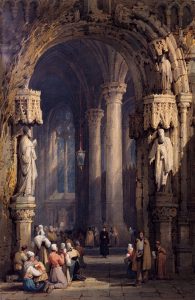Miyamoto Musashi.
A samurai turned Buddhist monk
In the year 1700 Nabeshima Mitsushige, daimyo (lord) of the Saga domain, passed away. Yamamoto Jōchō, one of his samurai retainers, claims to have intuitively sensed his impending doom. From Kyoto, he rushed home: just in time to witness Mitsushige’s final moments. The death of the daimyo marked the end of Jōchō’s service.
He stated a desire to die with his lord by committing junshi: ritual suicide by self-immolation. This might, to say the least, strike us as a peculiar retirement plan. But at the time, it was held to be a supreme expression of loyalty. Still, his fellow clansmen intervened. Junshi was too radical even for the samurai of the Edo period and outlawed by both the Saga domain and the Tokugawa government.
Thus, Jōchō became a Buddhist monk instead. In the hills of Kurotsuchibaru, he would spend the rest of his life as a hermit. There, perhaps inadvertently, he became one of history’s most influential martial philosophers.
Ten years after he took the tonsure, a young samurai by the name of Tashiro Tsuramoto sought his council. The two developed a relationship of tutelage. Jōchō taught him his views on Budo: the Way of the warrior, or martial philosophy.
Ian James Kidd: Going Slow
A rhetoric of slowness and speed has been used by philosophers since the ancient periods to characterise and assess different ways of life.
Hidden by Leaves
Tsuramoto documented the doctrine over the course of seven years, in a work that would later be titled Hagakure: either translated into Hidden Leaves or Hidden by Leaves. The text only reached the public after the Meiji restoration of 1868. During the twentieth century, it was popularized by the Japanese ultranationalists. They used it as a propaganda tool: a reactionary attempt to instill the warrior spirit of old into their modern military.
Japanese war propaganda.
Unfortunately, the radicalism in Hagakure has led to much atrocity.
It produced fanatics: soldiers ready to die for their country, who simultaneously bore no respect for opponents who were not. The former culminated in the suicidal kamikaze units. The latter in the sadistic prisoner camps erected across the Pacific.
Japanese martial philosophy has thus been mythologized to nefarious ends, but that does not mean it has nothing to teach well-adjusted individuals. Hagakure was first and foremost a commentary on the Way of the warrior. It attempts to capture a noble existence in the face of adversity. And although the average Westerner is not a military person, to each of us life still proves a battle from time to time.
Death and the Way
The most well-known quote from the book is as follows:
The Way of the warrior is to be found in dying.
This is directly followed by:
If one is faced with two options of …
Originally appeared on Daily Philosophy Read More






